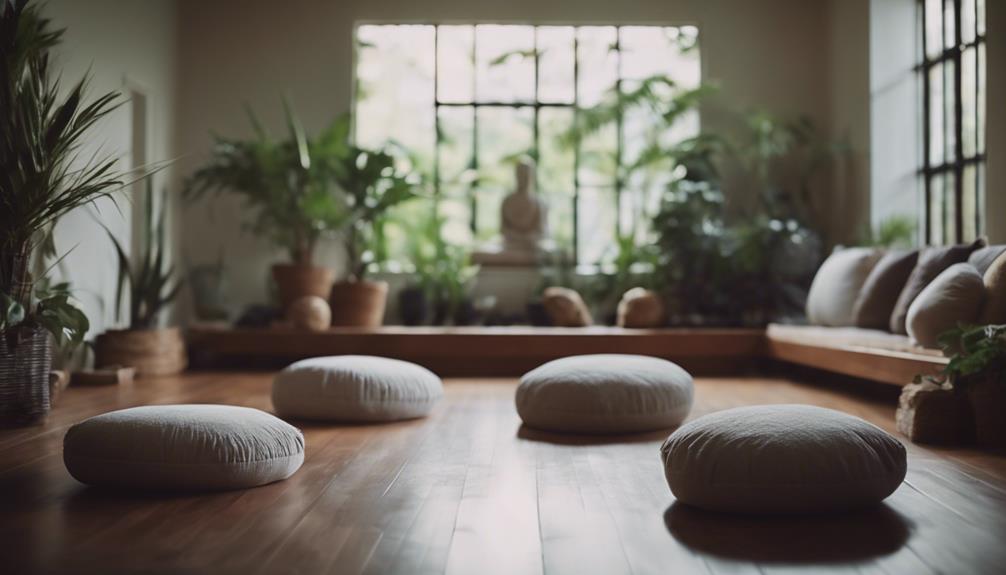The Art of Relaxation: Starting a Meditation Center
In the fast-paced world we live in, the saying 'calm waters run deep' holds true. Imagine a sanctuary where individuals can unwind, find peace, and recharge their spirits.
But how do you create such a haven? Through meticulous planning, thoughtful design, and a deep understanding of the art of relaxation.
Dive into the intricacies of establishing a meditation center that not only offers solace but also cultivates a space for profound self-discovery and holistic rejuvenation.
Key Takeaways
- Choose locations blending tranquility and accessibility for the meditation center.
- Create a serene ambiance with Zen decor, natural elements, and guided sessions.
- Develop diverse meditation programs to cater to a wide audience inclusively.
- Prioritize qualified instructors and wellness workshops for enhancing meditation practices.
Choosing the Ideal Location
When selecting the perfect location for your meditation center, consider the tranquility and accessibility that will best serve your community. Begin by scouting locations, weighing the benefits of urban versus rural settings. Urban areas offer accessibility and visibility, potentially attracting a larger audience. However, the hustle and bustle may hinder the peaceful ambiance you seek to create. On the other hand, rural locations provide serene surroundings conducive to meditation but might pose challenges in terms of accessibility.
Budget considerations are crucial in your decision-making process. Conduct a thorough cost analysis to determine if the location aligns with your financial resources. Remember, the goal is to create a space that fosters inner peace without compromising your financial stability. It's essential to strike a balance between the ideal setting and financial feasibility.
Ultimately, the location you choose will significantly impact the success of your meditation center. By carefully considering factors like tranquility, accessibility, and budget, you can create a space that resonates with your community and fulfills your vision of a peaceful sanctuary for all.
Crafting a Serene Ambiance
To create a truly serene ambiance at your meditation center, focus on harmonizing elements that promote peace and tranquility throughout the space. Embracing Zen decor is essential for cultivating a tranquil atmosphere that supports mindfulness and relaxation. Incorporate natural materials like wood and stone, soft lighting, and minimalistic design to create a soothing environment that encourages inner peace.
| Zen Decor | Tranquil Atmosphere | Suggestions |
|---|---|---|
| Use earthy tones and natural textures | Play soft instrumental music | Consider adding a small indoor fountain |
| Include plants for a touch of greenery | Ensure comfortable seating cushions | Integrate aromatherapy with essential oils |
| Opt for simple and clutter-free spaces | Encourage a no-tech policy | Offer guided meditation sessions |
| Display calming artworks or quotes | Provide blankets for warmth | Arrange silent meditation hours |
Developing Meditation Programs
Emphasize the importance of diversity and inclusivity when developing meditation programs at your center. Tailoring your programs to cater to a wide range of individuals ensures that everyone feels welcome and valued. Incorporating mindfulness practices and various meditation techniques can offer a rich tapestry of experiences for your participants. Encourage a sense of community by providing sessions that resonate with people from different backgrounds and belief systems.
When designing your meditation programs, consider offering a mix of guided meditations, breathwork exercises, visualization techniques, and body scans. This variety allows individuals to explore what works best for them and discover new ways to connect with their inner selves. By embracing diversity in your programs, you create a space where everyone can find solace and peace, regardless of their previous experience with meditation.
Creating Sacred Spaces
Consider the ambiance and intention you want to cultivate when creating sacred spaces within your meditation center. Sacred rituals and mindful practices are at the heart of these spaces, offering tranquility and a sense of connection.
Start by choosing a location within your center that feels peaceful and conducive to introspection. Whether it's a dedicated room or a cozy corner, ensure that the space is free from distractions and clutter.
Incorporate elements like soft lighting, calming colors, and natural textures to create a soothing atmosphere. Add cushions or mats for comfortable seating during meditation sessions. Consider including plants or symbolic objects that hold meaning for your practice. These details can enhance the overall experience and encourage a deeper sense of presence.
Incorporating Mindful Design
As you embark on this journey to create a meditation center, remember that every element of your space should reflect peace and tranquility.
From the layout of the rooms to the choice of colors, ensure that everything promotes a sense of calmness and mindfulness.
Serene Space Layout
Creating a serene space layout for your meditation center involves intentional placement of elements that promote tranquility and mindfulness. To achieve this, consider incorporating a Zen garden for a peaceful focal point and utilizing tranquil lighting to create a soothing ambiance. Here's a simple guide to help you create a harmonious space:
| Element | Purpose |
|---|---|
| Zen garden | Promotes relaxation and |
| connection with nature. | |
| Tranquil lighting | Enhances the calming |
| atmosphere of the space. |
Calming Color Palette
To cultivate a serene atmosphere in your meditation center, select a calming color palette that embraces mindful design principles. Mindful decor plays a crucial role in creating a tranquil environment that encourages relaxation and focus.
Opt for soft, soothing tones like gentle blues, earthy greens, or muted neutrals to promote a sense of peace and harmony. These colors can help individuals unwind and connect with their inner selves more effectively.
Consider incorporating elements of nature into your color scheme, such as warm browns or soft yellows, to evoke feelings of grounding and serenity. Remember, the colors you choose can greatly impact the overall ambiance of your meditation center, so choose wisely to foster a space that nurtures mindfulness and calmness.
Establishing Community Connections
Forge genuine connections with the local community to lay a strong foundation for your meditation center's growth and impact. Building relationships and fostering community engagement are key to creating a welcoming space for individuals seeking tranquility and mindfulness. Here are four essential steps to help you establish meaningful connections with the community:
- Host Open Houses: Invite the community to visit your center, meet the instructors, and learn about the benefits of meditation. Providing a glimpse into your space can spark interest and encourage participation.
- Collaborate with Local Businesses: Partner with nearby businesses to host joint events or workshops. This collaboration not only strengthens community ties but also exposes your center to a broader audience.
- Offer Community Classes: Consider offering free or donation-based meditation classes to make your center accessible to individuals from all walks of life. This inclusivity can attract diverse participants and create a sense of belonging.
- Volunteer in the Community: Get involved in local events, charities, or initiatives to show your commitment to the well-being of the community. Volunteering not only benefits those in need but also enhances your center's reputation as a caring and engaged member of the community.
Training Experienced Instructors
Build a strong foundation for your meditation center by investing in the training of experienced instructors who embody mindfulness and are dedicated to guiding others on their journey towards tranquility and self-discovery. When selecting instructors, prioritize qualifications that demonstrate a deep understanding of meditation practices and a commitment to personal growth. Look for individuals who've completed reputable training programs and possess certifications in meditation instruction.
In addition to qualifications, consider the teaching techniques and methods that instructors use. Effective instructors employ a variety of approaches to accommodate different learning styles and preferences. They create a supportive and inclusive environment where participants feel comfortable exploring their inner selves. Encourage instructors to continuously enhance their skills through workshops, retreats, and ongoing education. By investing in the development of your instructors, you not only elevate the quality of your meditation center but also ensure that participants receive the highest level of guidance and support on their path to inner peace.
Hosting Wellness Workshops
When hosting wellness workshops at your meditation center, selecting themes that resonate with your audience is key to fostering a nurturing environment.
Carefully curating your instructor selection process ensures that you bring in experts who can guide participants effectively.
Workshop Themes Selection
Selecting the right themes for your wellness workshops is pivotal in engaging participants and fostering a transformative experience. When planning your workshop themes, consider the following:
- Mindfulness Practices: Introduce participants to various mindfulness techniques such as body scans, mindful breathing, and loving-kindness meditation to help them cultivate present-moment awareness.
- Relaxation Techniques: Incorporate sessions on progressive muscle relaxation, guided imagery, or yoga nidra to aid participants in releasing tension and achieving a state of deep relaxation.
- Workshop Planning: Create a well-rounded schedule that includes a mix of interactive exercises, group discussions, and individual reflection to cater to different learning preferences.
- Mindfulness Retreats: Offer themed retreats focusing on specific aspects like stress reduction, self-compassion, or mindful eating to provide a deeper dive into mindfulness practices.
Instructor Selection Process
To ensure the success of your wellness workshops, the process of choosing instructors who embody expertise and passion is crucial for creating an enriching and transformative experience for participants. When selecting instructors for your meditation center, focus on their qualifications in meditation techniques and teaching methods.
Look for individuals who not only have a deep understanding of various meditation practices but also possess effective teaching skills to guide participants through their journey of self-discovery and relaxation. Consider their ability to create a welcoming and supportive environment that nurtures personal growth and inner peace.
Implementing Relaxation Techniques
Consider incorporating soothing music or gentle breathing exercises to enhance the relaxation experience at your meditation center. These techniques can help create a serene and calming environment for your visitors. To further elevate the relaxation experience, here are some tips to consider:
- Breathing exercises: Encourage deep and mindful breathing techniques to help individuals center themselves and cultivate a sense of peace and tranquility.
- Guided imagery: Utilize guided imagery sessions to transport your visitors to peaceful and serene settings, allowing them to escape from their everyday worries and stress.
- Soothing music playlists: Curate calming music playlists that promote relaxation and aid in creating a soothing ambiance within your meditation center.
- Mindfulness practices: Introduce mindfulness activities that encourage individuals to focus on the present moment, promoting self-awareness and reducing stress levels.
Promoting Holistic Well-being
Enhance the overall well-being of your visitors by nurturing their mind, body, and spirit through a holistic approach at your meditation center. By promoting holistic well-being, you can create a space where individuals can truly thrive and find balance in their lives. Two essential aspects to focus on are mindful eating and stress management.
Promoting Holistic Well-being
Implementing mindful eating practices can help your visitors develop a healthier relationship with food. Encourage them to savor each bite, eat slowly, and pay attention to their body's hunger and fullness cues. This approach not only supports physical health but also enhances the overall dining experience, fostering a sense of gratitude and mindfulness.
Stress management techniques are crucial for maintaining a harmonious mind-body connection. Offer guided meditation sessions, yoga classes, and workshops on stress-relief strategies. Providing tools for relaxation and self-care empowers your visitors to navigate life's challenges with resilience and inner peace.
| Holistic Well-being Practices | Description |
|---|---|
| Mindful Eating | Practice eating with awareness and appreciation. |
| Stress Management | Learn techniques to manage stress and promote relaxation. |
Conclusion
As you embark on the journey of starting a meditation center, remember that it isn't just a physical space, but a sanctuary for the mind and soul. Just like a garden needs nurturing to bloom, your meditation center requires love and care to flourish.
So, tend to it with kindness and watch as it becomes a haven for those seeking peace and relaxation. Your efforts will ripple out like a stone dropped in a calm pond, spreading tranquility and healing to all who visit.







